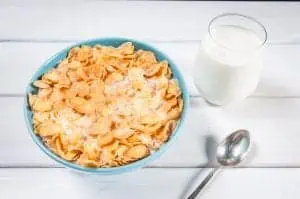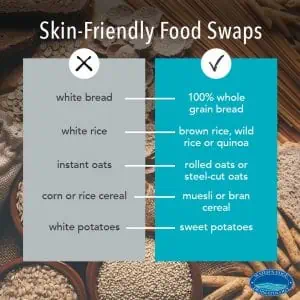 Pizza and chocolate cause acne — right, or wrong? Do any foods cause acne? Can the ideal diet help you avoid breakouts? Researchers have debated these answers for years. Finally, a consensus seems to be emerging, and the foods to limit probably aren’t the ones you think.
Pizza and chocolate cause acne — right, or wrong? Do any foods cause acne? Can the ideal diet help you avoid breakouts? Researchers have debated these answers for years. Finally, a consensus seems to be emerging, and the foods to limit probably aren’t the ones you think.
Hunting for answers
One hundred years ago, many doctors thought certain foods — everything from chocolate to nuts to starchy foods — could trigger acne outbreaks. However, by the 1970s, most scientists believed there was no connection between diet and acne. Some removed chocolate from the list of culprits after a study found that eating chocolate didn’t increase production of sebum, an oily substance produced by the sebaceous glands that can clog hair follicles, causing breakouts.
But many experts today think certain foods do contribute to acne — and whoever first proposed starchy foods as a culprit was probably onto something.
The tides turned in 2002, when an international team of researchers studied the faces, necks, chests and backs of 1,200 people (including teenagers) in Papua New Guinea and didn’t find a single pimple. They strongly suspected the local diet was at least part of the reason. That diet consisted mostly of fish, coconut and a great deal of plant foods. As the scientists noted, “Virtually all of the dietary carbohydrate intake was in the form of low-glycemic load tubers, fruits and vegetables.”
In other words, what the diet didn’t contain was high-glycemic foods — the foods (and drinks) that cause blood sugar to spike. These include white bread, white pasta, white rice, soda, cookies, desserts and many cereals.
The same researchers later studied members of a tribe of hunter-gatherers in Paraguay. Again: no pimples.
The glycemic index and acne
Since 2002, researchers have found a link between a diet rich in high-glycemic foods and acne. “Studies indicate that there really is a correlation,” said Danica Alexander, DO, a dermatologist at Water’s Edge Dermatology.
Some of those studies suggest that swapping high-glycemic foods for low-glycemic ones can make acne less severe. Low-glycemic foods include most vegetables, many fruits, beans and whole grains, such as steel-cut oats. In one study, 87% of people who adopted a low-glycemic diet to lose weight said their skin improved within three months. Most of the study subjects who used acne medication said they were able to use less.
[su_pullquote align=”right”]A quick rise in blood sugar causes the body to make more sebum. It also promotes inflammation.[/su_pullquote]
Why might high-glycemic foods contribute to acne? One reason is that a quick rise in blood sugar causes the body to make more sebum. It also promotes inflammation. The combination can lead to acne breakouts.
Got (too much) milk?
Milk doesn’t spike blood sugar as high-glycemic beverages do, but it looks milk — even skim milk — might contribute to acne in other ways, at least in some people. Some scientists believe milk worsens acne by increasing pore-clogging inflammation. It might also increase levels of certain hormones that stimulate production of sebum.
More research is needed, but a 2019 paper that examined 14 studies concluded that people who drink the most milk are about 50% more likely to have acne than those who drink the least. Consuming other dairy foods, such as yogurt and cheese, wasn’t associated with acne.
Cutting out milk isn’t for everyone, especially since it’s a good source of important vitamins and minerals. “If you decide to limit dairy, I always recommend taking vitamin D and calcium supplements,” said Dr. Alexander.
An acne-fighting diet?

Start by piling more of your plate with fresh vegetables (except potatoes), fruits and beans. Also, trade:
- White bread for 100% whole grain bread
- White rice for brown rice, wild rice or quinoa
- Instant oats for rolled oats or, better yet, steel-cut oats
- Corn or rice cereal for muesli or bran cereal
- White potatoes for sweet potatoes
Avoid sugary beverages, and cut down on chips, pretzels, dessert and candy. (That includes milk chocolate bars, which contain both sugar and dairy.)
It may take a few months to see a difference. And don’t expect pimples to entirely disappear.
“Will diet cure acne? No,” said Dr. Alexander. “But it definitely can help improve it.” Chances are, moving toward a lower-glycemic diet will yield other positive health effects as well.
Article Written By: Timothy Gower, an award-winning journalist who writes about medicine and health. His work has appeared in more than two dozen national magazines.





